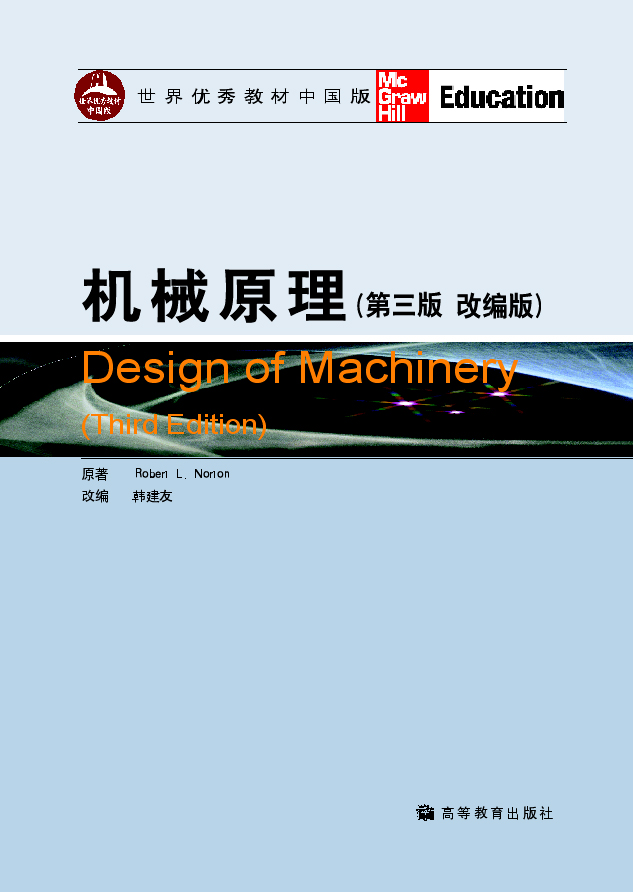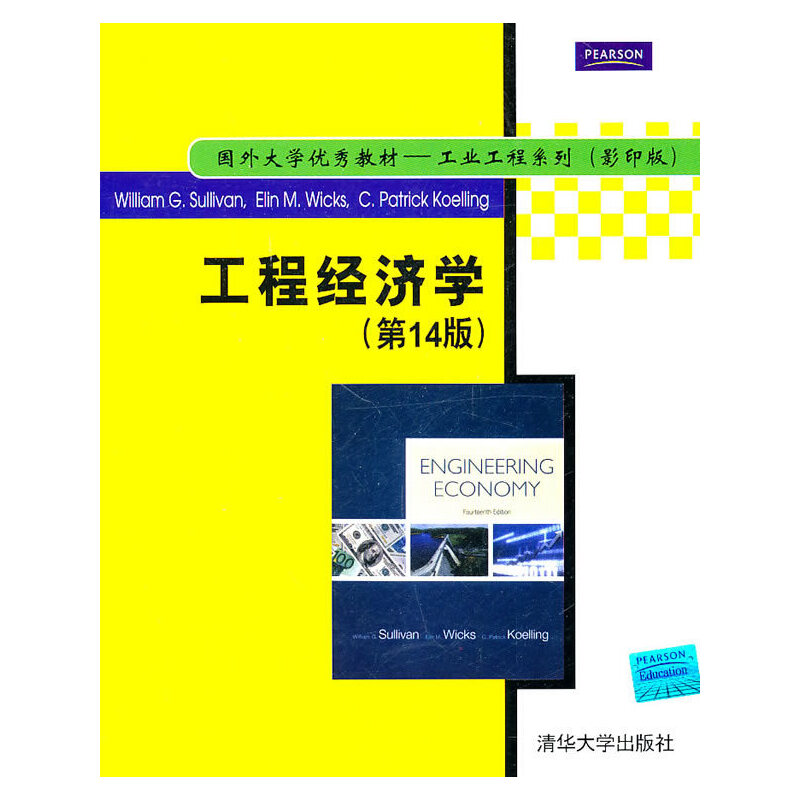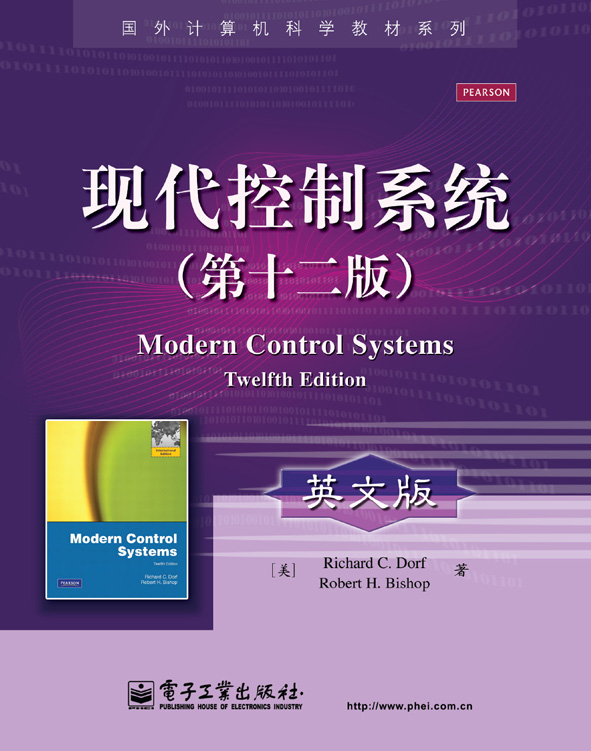机械原理(第3版)(改编版)
作者: Robert L. Norton等著,韩建友改编
出版时间:2007-05-25
出版社:高等教育出版社
- 高等教育出版社
- 9787040212556
- 1
- 190151
- 0045154707-9
- 平装
- 16开
- 2007-05-25
- 620
- 381
Robert L.Norton著的《Design of machinery:all introduction to the synthesis and analysis ofmechanisms andmachines》是美国比较广泛应用的机械原理教材。该书在2004年出版了第三版。在我国已经出版了该书第二版的影印本和翻译本。现把该书第三版改编为内容适合我国机械原理教学基本要求的简本,供我国机械原理双语教学使用,也可作为机械原理教学的辅助教材,还可供机械工程方面的专业人员参考。该书内容丰富,大部分内容适合我国机械类本科生的教学要求。原书858页,共包括16章的内容、参考文献和习题、6个附录、1个索引和1个光盘目录。其中第1章至第9章为第一部分(PART I),称为机构运动学;第10章至第16章为第二部分(PARTⅡ),称为机械动力学。
Preface to the Third Edition
Preface to the First Edition
Chapter 1 Introduction
1.0 Purpose
1.1 Kinematics and Kinetics
1.2 Mechanisms and Machines
1.3 A Brief History of Kinematics
1.4 Applications of Kinematics
1.5 The Design Process
Design, Invention, Creativity
Identification of Need
Background Research
Goal Statement
Performance Specifications
Ideation and Invention
Analysis
Selection
Detailed Design
Prototyping and Testing
Production
1.6 Other Approaches to Design
Axiomatic Design
1.7 Multiple Solutions
1.8 Human Factors Engineering
1.9 The Engineering Report
1.10 Units
1.11 What’s to Come
Chapter 2 Kinematics Fundamentals
2.0 Introduction
2.1 Degrees of Freedom (DOF) or Mobility
2.2 Types of Motion
2.3 Links, Joints, and Kinematic Chains
2.4 Determining Degree of Freedom or Mobility
Degree of Freedom (Mobility) in Planar Mechanisms
Degree of Freedom (Mobility) in Spatial Mechanisms
2.5 Mechanisms and Structures
2.6 Paradoxes
2.7 Linkage Transformation
2.8 Intermittent Motion
2.9 Inversion
2.10 The Grashof Condition
2.11 Compliant Mechanisms
2.12 Micro Electro-Mechanical Systems (MEMS)
2.13 Practical Considerations
Pin Joints versus Sliders and Half Joints
Cantilever or Straddle Mount?
Short Links
Bearing Ratio
Commercial Slides
Linkages versus Cams
Chapter 3 Graphical Linkage Synthesis
3.0 Introduction
3.1 Synthesis
3.2 Function, Path, and Motion Generation
3.3 Limiting Conditions
3.4 Dimensional Synthesis
Two-Position Synthesis
Three-Position Synthesis with Specified Moving Pivots
Three-Position Synthesis with Alternate Moving Pivots
Three-Position Synthesis with Specified Fixed Pivots
Position Synthesis for More Than Three Positions
3.5 Quick-Return Mechanisms
Fourbar Quick-Return
Sixbar Quick-Return
3.6 Coupler Curves
Chapter 4 Position Analysis
4.0 Introduction
4.1 Coordinate Systems
4.2 Position and Displacement
Position
Coordinate Transformation
Displacement
4.3 Translation, Rotation, and Complex Motion
Translation
Rotation
Complex Motion
Theorems
4.4 Graphical Position Analysis of Linkages
4.5 Algebraic Position Analysis of Linkages
Vector Loop Representation of Linkages
Complex Numbers as Vectors
The Vector Loop Equation for a Fourbar Linkage
4.6 The Fourbar Slider-Crank Position Solution
4.7 An Inverted Slider-Crank Position Solution
4.8 Linkages of More Than Four Bars
The Geared Fivebar Linkage
Sixbar Linkages
4.9 Position of any Point on a Linkage
4.10 Transmission Angles
Extreme Values of the Transmission Angle
4.11 Toggle Positions
Chapter 5 Analytical Linkage Synthesis
5.0 Introduction
5.1 Types of Kinematic Synthesis
5.2 Precision Points
5.3 Two-Position Motion Generation by Analytical Synthesis
5.4 Comparison of Analytical and Graphical Two-Position Synthesis
5.5 Simultaneous Equation Solution
5.6 Three-Position Motion Generation by Analytical Synthesis
5.7 Comparison of Analytical and Graphical Three-position Synthesis
5.8 Synthesis for a Specified Fixed Pivot Location
Chapter 6 Velocity Analysis
6.0 Introduction
6.1 Definition of Velocity
6.2 Graphical Velocity Analysis
6.3 Instant Centers of Velocity
6.4 Velocity Analysis with Instant Centers
Angular Velocity Ratio
Mechanical Advantage
Using Instant Centers in Linkage Design
6.5 Velocity of Slip
6.6 Analytical Solutions for Velocity Analysis
The Fourbar Pin-Jointed Linkage
The Fourbar Slider-Crank
The Fourbar Inverted Slider-Crank
6.7 Velocity Analysis of The Geared Fivebar Linkage
6.8 Velocity of any Point on a Linkage
Chapter 7 Acceleration Analysis
7.0 Introduction
7.1 Definition of Acceleration
7.2 Graphical Acceleration Analysis
7.3 Analytical Solutions for Acceleration Analysis
The Fourbar Pin-Jointed Linkage
The Fourbar Slider-Crank
Coriolis Acceleration
The Fourbar Inverted Slider-Crank
7.4 Acceleration Analysis of the Geared Fivebar Linkage
7.5 Acceleration of any Point on a Linkage
7.6 Human Tolerance of Acceleration
7.7 Jerk
7.8 Linkages of n Bars
Chapter 8 Cam Design
8.0 Introduction
8.1 Cam Terminology
Type of Follower Motion
Type of Joint Closure
Type of Follower
Type of Cam
Type of Motion Constraints
Type of Motion Program
8.2 S V A J Diagrams
8.3 Double-Dwell Cam Design—Choosing S V A J Functions
The Fundamental Law of Cam Design
Simple Harmonic Motion (SHM)
Cycloidal Displacement
Combined Functions
The SCCA Family of Double-Dwell Functions
Polynomial Functions
Double-Dwell Applications of Polynomials
8.4 Single-Dwell Cam Design—Choosing s v a j Functions
Single-Dwell Applications of Polynomials
Effect of Asymmetry on the Rise-Fall Polynomial Solution
8.5 Critical Path Motion (CPM)
Polynomials Used for Critical Path Motion
8.6 Sizing the Cam—Pressure Angle and Radius of Curvature
Pressure Angle—Translating Roller Followers
Choosing a Prime Circle Radius
Overturning Moment—Translating Flat-Faced Follower
Radius of Curvature—Translating Roller Follower
Radius of Curvature—Translating Flat-Faced Follower
Chapter 9 Gear Trains
9.0 Introduction
9.1 Rolling Cylinders
9.2 The Fundamental Law of Gearing
The Involute Tooth Form
Pressure Angle
Changing Center Distance
Backlash
9.3 Gear Tooth Nomenclature
9.4 Interference and Undercutting
Unequal-Addendum Tooth Forms
9.5 Contact Ratio
9.6 Gear Types
Spur, Helical, and Herringbone Gears
Worms and Worm Gears
Rack and Pinion
Bevel and Hypoid Gears
Noncircular Gears
Belt and Chain Drives
9.7 Simple Gear Trains
9.8 Compound Gear Trains
Design of Compound Trains
Design of Reverted Compound Trains
An Algorithm for the Design of Compound Gear Trains
9.9 Epicyclic or Planetary Gear Trains
The Tabular Method
The Formula Method
9.10 Efficiency of Gear Trains
9.11 Transmissions
9.12 Differentials
Chapter 10 Dynamic Force Analysis
10.0 Introduction
10.1 Newtonian Solution Method
10.2 Single Link in Pure Rotation
10.3 Force Analysis of a Threebar Crank-Slide Linkage
10.4 Force Analysis of a Fourbar Linkage
10.5 Force Analysis of a Fourbar Slider-Crank Linkage
10.6 Force Analysis of the Inverted Slider-Crank
10.7 Force Analysis—Linkages with More Than Four Bars
10.8 Shaking Forces and Shaking Torque
10.9 Linkage Force Analysis by Energy Methods
10.10 Controlling Input Torque—Flywheels
10.11 A Linkage Force Transmission Index
10.12 Practical Considerations
Chapter 11 Balancing
11.0 Introduction
11.1 Static Balance
11.2 Dynamic Balance
11.3 Balancing Linkages
Complete Force Balance of Linkages
11.4 Effect of Balancing on Shaking and Pin Forces
11.5 Effect of Balancing on Input Torque
11.6 Balancing the Shaking Moment in Linkages
11.7 Measuring and Correcting Imbalance
Vocabulary of the key terms重要名词术语英汉对照表










